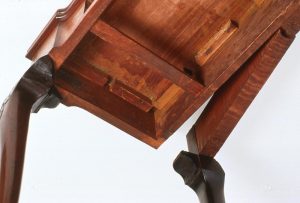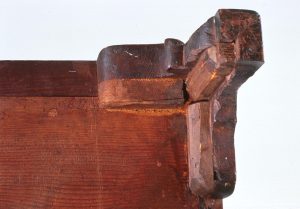We may receive a commission when you use our affiliate links. However, this does not impact our recommendations.
I’m often asked about blocking on feet (sad, but true). Woodworkers want to know how bracket and ogee feet were attached and how to deal with cross-grain gluing. The answers to these questions are: lots of ways, and you don’t necessarily have to because they didn’t.
Cross-grain gluing and consideration of expansion and contraction wasn’t a universal primary concern. Now, I know the first photo isn’t of feet, but it illustrates my point. The Boston card table top is attached to the base of the table with…glue blocks; both with and across the grain. This is not atypical for period construction.
You have to remember that their environments within their homes was only marginally different from the environment without. This means the materials are going to expand and contract pretty much the same way they did when they were stickered and drying – at a rate about equal with the changes in the weather. But the important thing is the old guys knew the overall trend for wood is contraction. No matter how humid it gets, eventually it all shrinks. That’s the nature of what happens as wood desiccates.
When left to equalize with the world around it, the dimensional changes of the wood are more gradual. This usually means that by the time it has expanded or contracted to the point where damage is about to occur, the weather starts working its way toward the opposite extreme. It truly was a kinder, gentler world – on our furniture, at least.
So, what’s this got to do with feet? They didn’t worry about how the grain direction of the blocks interfered with the expansion and contraction of the foot facings or the case parts. They just attached them so they wouldn’t fall off.
Often feet merely consisted of a vertical corner block, two horizontal blocks and the foot facings. Others were attached with a large horizontal block (almost a secondary, partial bottom) and then glue blocked in place. In the end, what was important was to make feet that were sturdy enough to carry the weight of the piece of furniture and allow it to be dragged around to different positions in the home while remaining attached to the case.
Is this mindset valid in the age of central heat and air conditioning? I believe it is (and have built all my pieces using the period correct methods) because I am trying to reproduce pieces that mimic what was made during a certain time period; and in 35 years of building this furniture I’ve never had a piece with a problem. And while the pieces illustrated have most likely had some maintenance to the blocks, feet and/or case parts, they’re still ticking. Replacing a block or patching a crack is just part of owning a piece crafted in this manner. To me, it also adds greatly to the patina of the piece. Feel free to deviate as you see fit.
All photos are courtesy of the Chipstone Foundation.
Here are some supplies and tools we find essential in our everyday work around the shop. We may receive a commission from sales referred by our links; however, we have carefully selected these products for their usefulness and quality.














Great post Chuck, I especially liked the close-up photos.
http://www.woodworkingwithajo.com